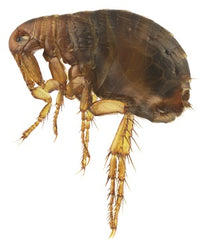
Why is Your Dog Scratching?
How to help with your dog's scratching
Summer’s here, and with it peak season for itchy dogs! If you’ve noticed your dog scratching and are looking for tips to soothe that itchy urge, you’re in the right place. This week, we’re blogging about dog scratching – the common causes, and how you can help your best friend feel more comfortable in their skin again.
According to The Bark, dog scratching is the second most common reason people take their dogs to the vet (sensitive tums top the list). So why do dogs scratch, and how can you help them feel less itchy? Let’s take a closer look…
Why is your dog scratching?
Let’s start at the root of the scratching – the urge to itch. There’s lots of detail about why dogs might feel itchy in this article, but in a nutshell, there are 3 broad reasons:
- Fleas, ticks, mites and mange
- Dry skin, environmental allergies and sensitive skin
- Dietary sensitivities and allergies
How to check for ticks and fleas
Ticks and fleas are very common, especially in summertime. Fleas particularly love hot weather, so if you’ve forgotten the spot on flea and tick treatment, solving your dog’s scratching could be quick and easy.
So how do you know if your dog has unwanted guests on board?
- Take a good look around ears, groin, neck and belly – look out for raised bumps and signs of scratching (like redness), or fleas and ticks themselves.
- If you’re not sure if your dog has fleas or not, stand them on a light coloured sheet and groom them – if you’ve groomed out some little black specks or spots, they may have fleas.
- Pick up some of the spots, and put them on damp kitchen paper. If the paper around the spots turns reddish brown, it’s flea waste.

Ticks are large enough to spot easily. However, it’s important to remove them very carefully – the Blue Cross gives good guidance here. If you are particularly worried about their removal, do speak to your vet or groomer and nutrition – factors for your dogs’ health
Fighting fleas and ticks
When it comes to ticks and fleas, prevention is better than cure – so try and keep your spot-on treatments up to date (we set calendar reminders on our phones!) If you do have a flea infestation, you’ll need to treat your dog and your home – there’s a full guide to fighting fleas here, but in summary:
- Bathe your dog in flea shampoo, and apply a treatment like Flick spot-on flea and tick treatment.
- Wash everything washable – bedding, blankets, sofa throws, rugs etc – at 60 degrees.
- Spray your home with a vet-recommended flea spray – some are a lot more effective than others!
- Vacuum regularly – and empty the bag after every vacuuming session.
- Let your pet back into the infested area – their spot-on will kill remaining fleas.
- If you’re still not flea-free after a month or two, consider calling in the professionals.
Mange and other parasites
For more tips to spot and solve mites and mange, take a look at our guide to the causes of itching in dogs.
Pest-free – but your dog’s still scratching?
If the problem isn’t irritating pests, it’s likely to be dry skin, an allergy or a sensitivity – so it’s time for some detective work to get to the root of what’s causing the itch.
Dry skin
Perhaps the most common reason dogs scratch, and thankfully, the easiest to spot and soothe! It’s usually down to not enough skin-supporting omega oils in their diet, or too much bathing. Spotting dry skin in dogs is simple – check out our guide to healthy dog skin here. Flakes, redness and – you guessed it – scratching are the top clues. To soothe doggie dry skin, simply:
- Use a dog-specific shampoo and bathe according to the guidelines on the bottle.
- Add an Omega 3 & 6 supplement like YuDERM Dog or YuDERM Itchy Dog to their food.
- Feed a good quality, complete diet.
Environmental sensitivities and allergies
When it comes to allergies and sensitivities, let’s start with the easier one – environmental factors. There are 5 simple steps to take to start your detective work!
- Check the pollen count – hay fever in dogs is very common, and though some dogs may sneeze and get watery eyes, lots of scratching is the most common sign.
- Keep an itch diary – note when your dog is scratching. What did you do in the hour before?
- Take a look at your shopping list – have you started to use a new or different household cleaning product?
- Have you changed your routine – new places can mean new triggers, so if your pooch has started to scratch after changing doggy daycare, you’ve got a big clue!
- Have you changed their diet – including treats! If so, skip to the next section.
If you noticed no patterns and nothing has changed, it may be time to visit your vet.
How to stop your sensitive dog scratching
Sometimes allergies and sensitivities need medicated shampoo or oral medication from your vet, but there are natural ways to help, too.
- Avoid the trigger – simple, really. If you’ve changed or added something, revert to your old routine.
- Reduce the impact – if you think your dog might have hay fever, check out our guide to helping dogs with pollen allergies. There are lots of practical ways to reduce scratching.
- Support their skin – if you can’t avoid or minimise whatever is causing the itch, support your dog’s skin with a supplement like YuDERM Itchy Dog.

Dietary sensitivities and allergies
Not all reactions are due to environmental factors, dry skin or pest. Some dogs scratch because they aren’t thriving on their diet. Foods that dogs can find sensitive can be surprising. The most common sensitivities tend to be things your dog’s ancestors wouldn’t have eaten: grains, milk and milk products, soy and so on. However, some dogs react to meats like beef and lamb, poultry. Eggs, fish and even veggies can be the culprit too.
There are two ways to work out your dog’s ‘trigger’ foods – allergy testing, or an elimination diet. Both should only be undertaken after a chat with your vet.
Helping dogs with dietary sensitivities
Once you know what your dog can’t tolerate well, the next step is finding a diet that excludes their trigger foods. There’s lots of advice in our article about feeding dogs with sensitive tummies – but in short, you’ll need to avoid whatever it is that’s causing the scratching. Then, with time and vigilance (no sneaky naughty treats!), your itchy dog will be looking and feeling great again.
Does your dog scratch a lot? How do you help to soothe their itches? Maybe you’ve a top tip you’d like to share? Please do leave a comment and share with our community.





